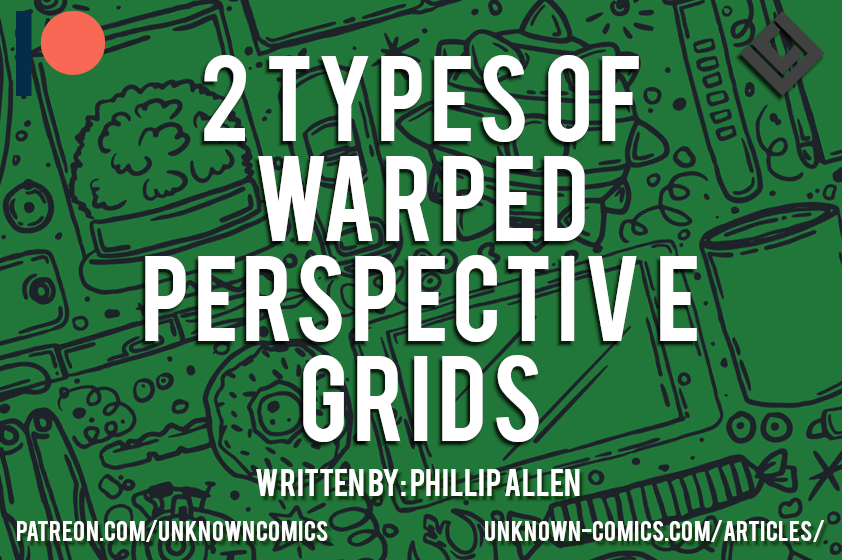As I touched on in my last article where I talked about the 3 types of linear perspective grids, this article will focus on the 2 types of warped perspective grids that can be used for illustrating comics.
Similar to the previous article, I’ll be discussing the basic characteristics of each warped perspective grid, what type of effect they provide the reader, and I will also touch on why you might want to use any of these for your comic illustrations.
What Are The Two Types of Warped Perspective Grids?
As I mentioned before, all the information you’ll find on this article can also be found and illustrated over on BaM Animation’s video on Perspective Grids, see below.
The 2 types of warped perspective grids we will discuss today are:
- The banana cap grid, and the...
- Spherical perspective grid.
As with each of the linear perspective grids, they have key characteristics that define the structure of each grid. Let’s get to talking about them, shall we?
Like the article so far? Support the production of more articles like this one!
The Banana Cap Perspective Grid
Characteristics of The Banana Cap Perspective Grid
This perspective grid is quite similar to the 2-point linear perspective grid that we discussed in the previous article, as in that it has two vanishing points.
What makes the banana cap perspective grid different from the 2-point perspective grid is that the lines protruding from one vanishing points are warped to aligning with the lines coming from the second vanishing point.
The finished grid looks similar to a banana, hence the name.
What Effect Do You Get With The Banana Cap Perspective Grids?
When using the banana cap warped perspective grid you’ll get a panoramic lens effect that, as referred in the video, gives the reader a fish island point of view.
This allows you to place far more background information.
The Spherical Perspective Grid
Characteristics of The Spherical Perspective Grid
When using spherical perspective grids, all vanishing points are made of spheres or parabolas (Quick Side Note: I personally get something resembling a panic attack when I come across quadratic mathematics lingo… but I must be strong…).
With spherical perspective grids, you can either have 2, 4, or even 5 vanishing points. It all depends on the types of guides you want to give yourself.
You can do this by using a 2-point spherical perspective grid, duplicating it, rotating it 90 degrees (to get a 4-point spherical grid), then adding a single vanishing point to the center (making it a 5-point spherical perspective grid).
What Effect Do You Get With The Spherical Perspective Grids?
When you want to deliver something approaching a 180-degree point of view you might want to consider using spherical perspective grids.
This gives a chance to for the 5 point perspective (as illustrated in the video) it’s a great way to emphasize a single object in the center. It gives a feeling similar to the one found in certain cathedral ceilings (i.e. St. Peter’s Basilica in Rome).
I personally think that this type of perspective grid is perfect for illustrating comic covers (but that’s just a suggestion, not a rule).
Conclusion
As I mentioned in the previous article, learning how to use these tools can help improve your comic illustrating process and ability. Learning when to use these tools (consider checking out the rest of the video by BaM Animation for their suggestion on the subject) can help make sure that your comic turns out looking amazing.
In the previous article, I mentioned how I was looking to learn how to develop an application to use on GIMP to quickly generate perspective grids. This is still a project I’m interested in working on. In the meantime, I have provided a set of perspective grid building kit which includes all number of types of vanishing points and even a spherical perspective grid. You can download them all at the bottom of my previous article’s Patreon post.
Download it and simply drop it into any comic project you’re working on in GIMP, move it around, and resize it to meet your needs.
Let me know if they came in handy!
Questions
Have you been using perspective grids in your comic illustrating process?
What have you found to be the best use of each of the perspective grids covered in both the last two articles?
Share your thoughts in the comments section below!
Sign Up For
The Unknown Times!
Content Updates
Website News
Recommended Reading
And More to Come!
*Once every two weeks!*
Liked the article? Become part of my Patreon Community!
About The Author

Phillip Allen
Writer, Editor, and Founder of Unknown Comics
Hello there! My name is Phillip Allen and I'm the writer, editor, and founder of Unknown Comics. I am an aspiring comic book creator. In an attempt to learn how to create my own comic I came to learn just how few reliable resources existed out there. From a few books and unhelpful websites I decided to focus my attention on researching and writing a resource for both myself and the rest of the comic creating industry. This website and and its content is the result of all of that hard work.

